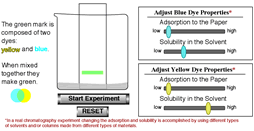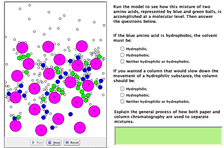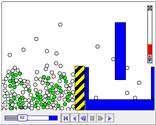CHAPTERS and MEDIA LINKS
- RELEVANT BOOK SECTIONS
- FLASH MEDIA
- CC JAVA-BASED ACTIVITIES
Intro/Scientific Method
- Intro
- Welcome to Chem
2! Your first assignment is
to give me some information about you.
- Handout: Text
Notes for this Unit, Expectations
and Late Passes
- Demo: Gummy Bear Safety
- Lab: Alchemist's
Dream Come True (sort of)
- What is chemistry?
- Set up lab drawers.
- Doing Science
- The Glowing Tomato
- Homework: Write up a plan for how you
would determine the safety of this tomato for public consumption.
- Scientific Method
- Homework: Read the
article on "Smoking Moms" and determine which group is the
control and which is the experimental. Write a short paragraph explaining
why you made this choice.
- How does a candle work? If you don't know, how would you test some ideas?
If you think you do know what tests could you do that would provide evidence
to support your theory?
- Lab: Determine how a candle works.
- Homework: Write as much as you can about
how you think a candle works. Make specific references to the experiments
you performed that lead you to believe your conclusions.
- Properties
- Properties Definition
- Demo: rubber balls of different composition
- Demo: three substances that look the same.
- Demo: properties of hydrogen and oxygen.
- What are the properties of candle wax?
- Homework: Pick a substance and describe
as many physical and chemical properties as you can. Be sure to categorize
each property as physical or chemical.
- Classification of Matter
- Pure Substances vs. Mixtures
- Homework: Element,
Mixture, and Compound sheet
- Chromatography
- Demo: chromatography of black marker
- Lab: How does chromatography work?
- Homework: Write up chromatography lab results.
How does this work? Make specific references to the experiments you performed
that lead you to believe your conclusions.
- Handout: Chromatography
guiding questions.
- Chromatography Details
- Computer Lab: Understanding Chromatography
Developed in conjunction with the Concord Consoritum and with support from the National Science Foundation. How to run this lab.
- Lab: Make chromatography bookmarks.
- Homework: Assuming that each dye which makes
up the color of a marker is a compound, draw a picture like that in the
Element, Mixture, and
Compound sheet to represent the following marker colors: yellow, green,
and black.
- Demo: Distillation as another example of separation through differences
in properties.
- First Quarter
Project - Here are some examples of good papers
- Example 1 - with
notations
- Example 2
- Example 3
- Test Review



